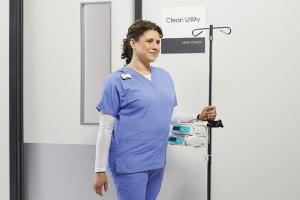Hygiene a key feature in plumbing equipment

Plumbing equipment manufacturers face many challenges when seeking to supply products to health care facilities. Infection prevention, ligature resistance, accessibility and ease of installation all play important roles in a health facility’s purchasing decisions.
As demonstrated by many recent product introductions targeting the health care field, however, the nation’s plumbing manufacturers have been taking note. Many current plumbing product trends are geared specifically to these and other health care concerns.
Infection prevention
Infection prevention and sensor-activated faucets have taken center stage in response to the far-reaching effects of the COVID-19 pandemic. Touchless hand-washing fixtures minimize restroom touch points and germ transmission — a critical factor in managing infection control. They also are easy to clean due to their sleek, compact design.
“Plumbing products that reduce touch points had a major moment at the start of the pandemic to limit the spread of germs, and there’s no sign that this trend is going away,” says James Walsh, leader for global products and fixtures at American Standard, Piscataway, N.J. “The 200% increase in searches for touchless products on our website is a clear indicator of that. Facilities managers also are looking for plumbing products with easy-to-clean spaces and surfaces, cleaner lines, and fewer nooks and crannies for germs and dirt to hide in.”
“Hygiene is increasingly important in hospital plumbing products, particularly now with COVID-19 and its strains continuing to infect people. That’s in addition to the risk of health care-associated infections (HAIs) and other viruses,” says Will Haas, senior product manager at Bradley Corp., Menomonee Falls, Wis. “There is a real need for hygienic washroom designs featuring touch-free activation, nonporous sink materials and washroom configurations to help improve infection control — and overall safety — of patients and staff.”
The pandemic has put the nation’s hospitals in a heightened safety mode, according to Mary Phelps, strategic sales manager and health care leader at Sloan, Franklin Park, Ill. Along with hands-free hygiene innovations, she says, antimicrobial products and solid surfaces also are trending, and health care facilities are shying away from hand dryers in favor of paper towels. “Increased water efficiency is still an ongoing trend, but the priority and focus has shifted toward health and safety.”
Touchless and low-touch features are a big part of new hospital plumbing products as facility managers contend with the increased presence of dangerous pathogens in sinks, showers and ice makers, as well as the threat of Legionella, according to Greg Hunt, commercial product manager at The Chicago Faucet Co., Des Plaines, Ill. “COVID-19 has ushered in the urgency to be as contactless as possible. Proper hand-washing has always been critical to preventing the spread of disease in hospitals; adding touchless faucets is a great way to reduce the chance of recontamination.”
In response to the pandemic, there is more concern about addressing infection control and using smart technologies and materials not only at the product level, but at the system level, says Andy Baines, general manager for Kohler kitchen and bath commercial products in Kohler, Wis. “This allows for tracking and compliance of systems to ensure they are delivering a safe and hygienic experience to users.” Baines also sees increased demand for plumbing products that minimize the impact of downtime at hospitals — products with quick installation and replacement solutions to ensure that patient rooms are not out of commission for long.
Manufacturers also are using new materials in their quest to improve infection control. Many sinks feature smooth and nonporous materials with seamless construction such as solid-surface and natural quartz, which prevent bacteria and mold from developing; these materials are easy to clean and sanitize.
“We’re seeing more attention given to materials such as stainless steel and antimicrobial copper-nickel alloy surfaces,” says Tauseef Ali, vertical marketing manager for health care at Zurn Industries LLC, Milwaukee. “These materials wipe clean easily and can help reduce germs on surfaces.” Ali notes that antimicrobial surfaces laboratory testing has shown that when cleaned regularly, these types of surfaces continuously reduce bacterial contamination, achieving 99.9% reduction within two hours of exposure.
“Materials ranging from stainless steel to solid surface are being introduced into health care settings to stop the spread of infection, as they offer easy-to-clean alternatives to traditional plumbing fixture materials,” says Rick Lewis, national sales manager for Willoughby Industries, Indianapolis. He adds that a variety of plumbing fixtures also have been introduced that are designed to protect patients from self-harm, including toilets, sinks, urinals and showers.
Bradley Corp. has introduced a line of touch-free Verge faucets, which use a laminar flow water pattern instead of incorporating aerators to control the water flow, to promote safe hand-washing. “Laminar flow helps prevent bacteria, such as Legionella, from being pulled into the faucet where an aerator mixes the air and water, which can cause the bacteria to proliferate,” Haas says. Based on its hygienic benefits, Bradley has added laminar flow as a specification to other touchless hand-washing solutions, such as the faucet used in its WashBar Duo.
Willoughby Industries has introduced the WICS Series infection control hand-washing sink — a single-user fixture designed to minimize splashing and reduce the spread of infectious diseases in health care environments. The Americans with Disabilities Act (ADA)-compliant sink features an offset drain and oversized backsplash as well as a one-piece, seamless construction of AquaSurf cast polymer resin — a stain-, impact- and burn-resistant solid surface material available in nine colors.
Kohler has introduced the Rada Digital Faucet, which offers true hands-free operation, including touchless temperature control and responsive sensor technology. The design conforms to the human hand and minimizes cracks and crevices for easy cleaning. It also features the required spout clearance while minimizing the retained water found in traditional gooseneck styles.
“This design eliminates the stagnation associated with solenoid designs,” Baines says. “The water is conditioned within the waterway and exits through a plain outlet in a laminar state, eliminating the need for contamination-prone flow inserts.” The digital valve enables control of all aspects of the faucet. It can change flow rate and temperature range, and switch between timed flow, on/off or blocking, depending on need. It is capable of a blended-duty flush or cold-only flush.
The BASYS guided hand-washing faucet from Sloan features an LCD display that provides instructions on how to follow the five-step hand-washing process. “Bluetooth-connected faucets and flushometers reduce the need to physically touch products in order to diagnose and adjust them. This can be done via the Sloan Connect App, which provides usage data that can optimize product performance,” Phelps says.
Sloan also offers open-front and arrowhead sinks that allow for convenient wheelchair access, so users can easily activate a faucet sensor without reaching over the front lip often found on other sinks. In addition, Sloan’s ST-2539-LR floor-mounted rear outlet ADA water closet with ligature resistance has been introduced to accommodate needs in mental health facilities.
American Standard’s Paradigm Selectronic touchless faucet, together with the company’s new Selectronic touchless sensor-operated foam soap dispenser, is designed to create a more hygienic environment. It also offers easy installation and maintenance. “The faucet’s sensor and touchless controls prevent direct contact that could spread bacteria; the soap dispenser is touchless as well,” Walsh says. The Cadet Toilet from American Standard also features a touchless flush.
Other considerations
When it comes to specifying and installing plumbing products, hospitals pose some challenges to vendors. Baines says that conflicting priorities, especially between sustainability initiatives and water quality and safety, is one challenge. “For example, green building programs look to minimize water and energy usage,” he says. “But in health care, it is important that enough water moves through the system to prevent stagnant conditions and keep water at the correct temperature to prevent the proliferation of waterborne pathogens.”
Phelps says that plumbing products should be ADA-compliant, especially when it comes to height and clearances in terms of sink enclosures. “Antimicrobial and laminar/multi-laminar flow faucets, bed pan lugs and ligature-resistant components are becoming increasingly popular in the hospital market,” she says. “However, finding products in compliance with ligature resistance is challenging because there is no singular authority that defines those specific standards.”
Water conservation always comes into the decision-making process, according to Ali. High-performing, low-flow toilets and urinals, and faucets with timeout features reduce water waste and costs. These solutions cut down on ghost activations, leaks or dripping from a manual handle not fully turned off. “When you consider the scale of some premises, the savings add up.”
Norva Plastics Inc., Norfolk, Va., has upgraded its behavioral health care faucet. The aerator has been replaced with a laminar flow aerator featuring antimicrobial material. Also, the faucet now features NanoSeptic material on the push handles.
“Powered by light, NanoSeptic surfaces utilize mineral nano-crystals, which create a powerful oxidation reaction,” says Patrick E. Keller, designer/inventor at Norva Plastics. The company also has introduced a universal anti-ligature shower handle that can be used by patients with prosthetic hands. The BH shower handle adapts to existing mixing valves, reducing installation time.
Willoughby Industries has unveiled the LRBHL-DMF Series behavioral health care lavatory — a single-user fixture designed to minimize ligature points that could provide patient tie-offs. The ADA-compliant lavatory features a ligature-resistant faucet and drain, as well as a solid, stainless-steel pedestal to conceal plumbing connections and fixture mounting points.
The Chicago Faucet Co. has introduced the BioArmor point-of-use, secondary water treatment device, which uses ultraviolet light LEDs to penetrate waterborne pathogen cells and render them microbiologically inactive. Featuring a plug-and-play design for easy installation, the device works with any dual-supply faucet, providing secondary water treatment at hand-washing sinks. It can be connected to a building automation system to remotely monitor errors and collect data on hot and cold water activations to help calculate UV lifespan and monitor faucet usage.
Speakman, Glen Mills, Pa., offers the Eyesaver sensor eyewash faucet with thermostatic mixing valve, which incorporates two separate water channels in the faucet body: one for the eyewash and the other for the faucet. When combined with a thermostatic mixing valve, this dual design ensures that the integrated eyewash delivers a consistently safe, tepid water temperature when flushing the eyes. Also, the company’s Optimus aerated spray creates a gentle cleansing experience for the affected eye area.
“Thermostatic valves are essential to keeping hospital patients and staff safe and to prevent scalding when using hot water,” adds Adam Horwitz, chief marketing officer. “Speakman offers thermostatic valves to complement all of its sensor-operated faucets. For undercounter use with hand-washing stations, the Speakman A-TMV valve is appropriate, while the CPV–5000 valve works with showering applications.”
Whitehall Manufacturing, City of Industry, Calif., has introduced Dignity Suites, a complete bathroom that creates a peaceful, well-balanced environment, which is especially important in behavioral health care facilities. “It is quick to install, easy to maintain and clean,” says Kristin Kahle, vice president. “The plumbing fixtures and accessories are stylish, with sleek lines for universal use, and ligature resistant.”
In addition, Whitehall Manufacturing recently partnered with W.D. Manor to manufacture a prefabricated modular dialysis supply wall box. “The W.D. Manor dialysis box protects the water source at the point of connection. It’s an entire system in a box: piping, valves, backflow and trap primer,” Kahle says.
‘Behind the wall’
In fact, Kahle sees hospitals moving to an integrated plumbing process where everything is connected both literally and digitally. “Facility managers will be paying closer attention to what is happening behind the wall, not just thinking about fixtures and surfaces when it comes to infection control. New digital systems will allow them to monitor and remotely manage their plumbing systems.”
Neal Lorenzi is a freelance writer and regular contributor based in Mundelein, Ill.
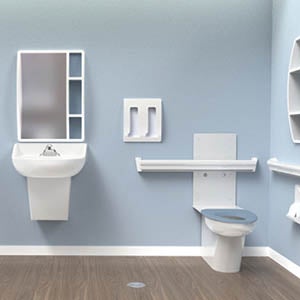
LOW MAINTENANCE
Dignity Suite features plumbing fixtures and accessories that are universally designed, easy to maintain, stylish and ligature resistant. Whitehall Manufacturing
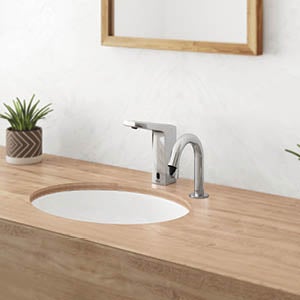
NO TOUCH
The Paradigm Selectronic touchless faucet, together with a sensor-operated foam soap dispenser, reduces touch points and improves cleanliness in hospitals. American Standard
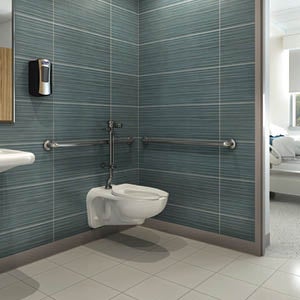
GERM FREE
Touch-free and antimicrobial restroom products are increasingly popular specifications in health care facilities of all types. Sloan
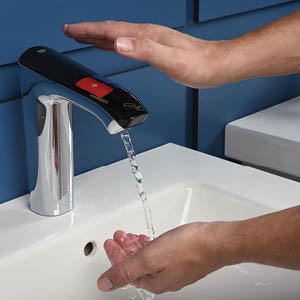
DOUBLE PROTECTION
The Rada digital faucet is designed to address challenges around infection control that are presented through touch as well as waterborne pathogens. Kohler
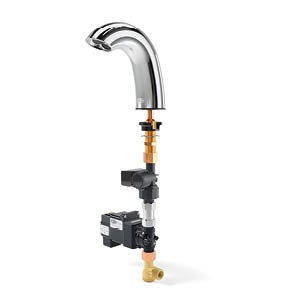
ENERGY SMART
The Hydro•X Power (shown in the Z6950-XL-S faucet) harvests energy with just a few activations per day, extending the faucet’s battery life for 10 years or more of uninterrupted power. Zurn Industries LLC
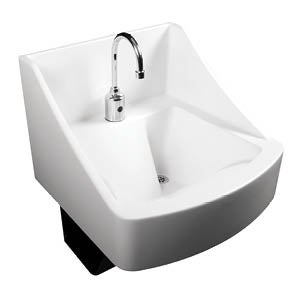
NO SPLASHING
This infection control sink features an indirect path to the drain, which keeps water from splashing directly into the drain and from aerosolizing trap contents. Willoughby Industries
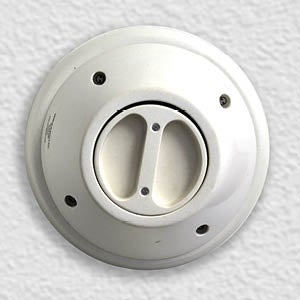
EXTRA ACCESSIBILITY
This universal, anti-ligature shower handle can be used by patients with prosthetic hands. Norva Plastics
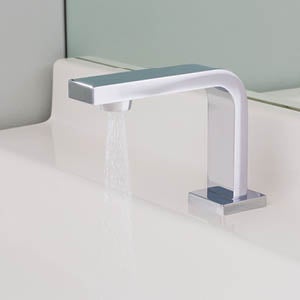
HIGH HYGIENE
Sensor-operated faucets like this battery-powered Sensorflo faucet are essential in hospital and clinic environments where meticulous hygiene is required. Speakman

SOCIAL DISTANCE
Omnideck basins made of Terreon solid surface material can be specified to provide greater space between handwashing areas. Bradley Corp.
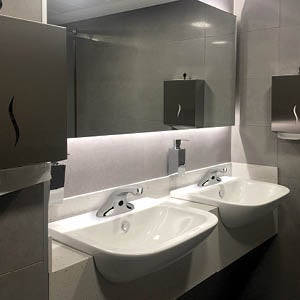
HEALTHY FLOW
Touchless faucets in all areas of the hospital — including public restrooms — avoid hand contamination during handwashing. The Chicago Faucet Co.
Neal Lorenzi is a Mundelein, Ill.-based contributor to Health Facilities Management.




